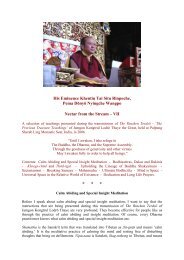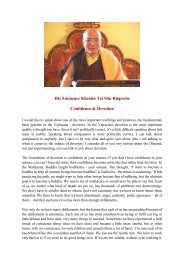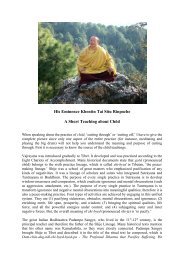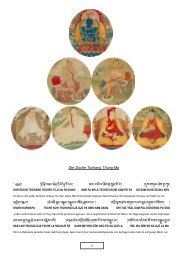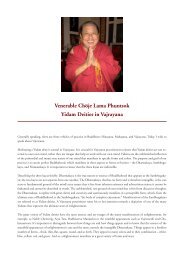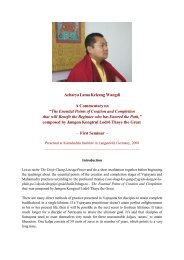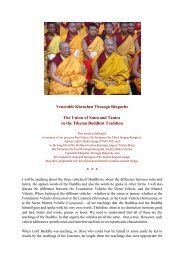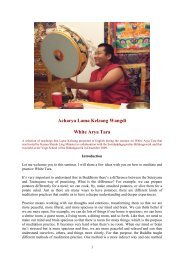Today we begin the conferral of all the empowerments, oral ...
Today we begin the conferral of all the empowerments, oral ...
Today we begin the conferral of all the empowerments, oral ...
You also want an ePaper? Increase the reach of your titles
YUMPU automatically turns print PDFs into web optimized ePapers that Google loves.
efers to <strong>the</strong> tradition up to <strong>the</strong> time <strong>of</strong> Lord Tsongkhapa. After his great seat <strong>of</strong> Ganden<br />
was established, this tradition was c<strong>all</strong>ed ”Gelugpa,” so Gelugpa and Kadampa are<br />
identical. Lamdre is <strong>the</strong> name <strong>of</strong> a cycle <strong>of</strong> spiritual teachings, so Sakya is <strong>the</strong> name <strong>of</strong><br />
<strong>the</strong> main seat <strong>of</strong> <strong>the</strong>se spiritual teachings, which is located in Tsang, Central Tibet.<br />
Marpa Kagyü is <strong>the</strong> lineage <strong>of</strong> pr<strong>of</strong>ound teachings that Master Marpa <strong>the</strong> Translator<br />
brought to Tibet from India; it is <strong>the</strong> lineage that derives from <strong>the</strong> students <strong>of</strong> <strong>the</strong><br />
incomparable Dakpo Rinpoche, Lhaje Gampopa. There <strong>we</strong>re four major schools that<br />
princip<strong>all</strong>y came from <strong>the</strong> First Karmapa, Düsum Khyenpa, and eight minor schools that<br />
<strong>we</strong>re founded by students <strong>of</strong> Phagmo Drupa. Among <strong>the</strong> four main schools <strong>of</strong> <strong>the</strong> Kagyü<br />
Tradition, <strong>the</strong>re is <strong>the</strong> Kamtsang Kagyü and its sub-schools, such as <strong>the</strong> Nedo, Zurmang,<br />
and Gyaltong. Distinguishing <strong>the</strong>m, four major and eight minor schools <strong>of</strong> <strong>the</strong> Kagyü<br />
Tradition evolved, which <strong>all</strong> descended from students <strong>of</strong> <strong>the</strong> incomparable Dakpo<br />
Rinpoche. They are collectively referred to as “Marpa Kagyü.” As for <strong>the</strong> Shangpa<br />
Kagyu Tradition, <strong>the</strong>re was a contemporary <strong>of</strong> Marpa Lotsawa, whose name was<br />
Khyungpo Näljor. He journeyed to India and received teachings from Niguma,<br />
Sukhasiddhi, and o<strong>the</strong>r great masters. The lineage he founded is c<strong>all</strong>ed “Shangpa Kagyü.”<br />
Some people think that <strong>the</strong> Shangpa Kagyü is one <strong>of</strong> <strong>the</strong> four major or eight minor<br />
schools just mentioned. These people may be learned in <strong>the</strong> scriptures, secular fields <strong>of</strong><br />
knowledge, pith instructions, practical methods, and so forth, but <strong>the</strong>y are a bit lacking in<br />
<strong>the</strong>ir knowledge <strong>of</strong> history! The Shije (‘Pacification’) Tradition is <strong>the</strong> lineage <strong>of</strong> <strong>the</strong><br />
Chöyül teachings that <strong>we</strong>re passed down from such Gurus as Padampa Sangye and<br />
Machik Lapchi Drönma. The Jordruk (‘Six Techniques <strong>of</strong> Union’) Tradition is also c<strong>all</strong>ed<br />
“Jonangpa.” Because it was passed down by Siddha Orgyenpa, <strong>the</strong> Dorje Nyendrup<br />
(‘Vajra Approach and Accomplishment’) Tradition is also c<strong>all</strong>ed <strong>the</strong> “Orgyen<br />
Nyendrup.” So, The Dam Ngagdzö is a collection <strong>of</strong> <strong>all</strong> instructions <strong>of</strong> <strong>the</strong> Eight Great<br />
Lineages <strong>of</strong> Accomplishment; in addition, Jamgon Kongtrul Rinpoche included a few<br />
cycles <strong>of</strong> teachings from <strong>the</strong> indigenous Tibetan Bon Tradition.<br />
Jamgon Kongtrul Lodrö Thaye travelled wherever it was necessary to receive rare and<br />
precious empo<strong>we</strong>rments, rare and precious <strong>oral</strong> transmissions, and invaluable<br />
instructions. He <strong>the</strong>n produced The Dam Ngagdzö collection, just as he ga<strong>the</strong>red <strong>all</strong><br />
cycles <strong>of</strong> <strong>the</strong> Kagyü teachings to produce The Kagyü Ngagdzö. He ga<strong>the</strong>red <strong>all</strong> <strong>the</strong> cycles<br />
<strong>of</strong> terma teachings to produce The Rinchen Terdzö. The Gyachen Kadzö contains works<br />
that Jamgon Kongtrul Rinpoche authored. And he collected his writings that covered <strong>the</strong><br />
entire range <strong>of</strong> fields <strong>of</strong> knowledge into The Shecha Dzö – ‘The Encompassment <strong>of</strong> All<br />
Knowledge.’ Fields <strong>of</strong> knowledge doesn’t only refer to spelling and grammar; but covers<br />
<strong>the</strong> ten traditional sciences. They are: rhetorics, astronomy and astrology, grammar,<br />
performing arts, lexicology, handicrafts, medicine, semantics, dialectics or logic, and Buddhist<br />
philosophy.<br />
From time to time, Jamgon Kongtrul Rinpoche learned about a lineage <strong>of</strong> teachings that<br />
was becoming exceedingly rare. He would travel to some isolated place, where <strong>the</strong><br />
lineage-holder who might be an old individual who couldn't even read very <strong>we</strong>ll was<br />
staying, and he would receive <strong>the</strong> lineage from him. He would look to where <strong>the</strong> lineages<br />
<strong>we</strong>re; he was not interested in receiving teachings from great Lamas or famous people<br />
and didn’t disregard humble and less popular lineage-holders.



